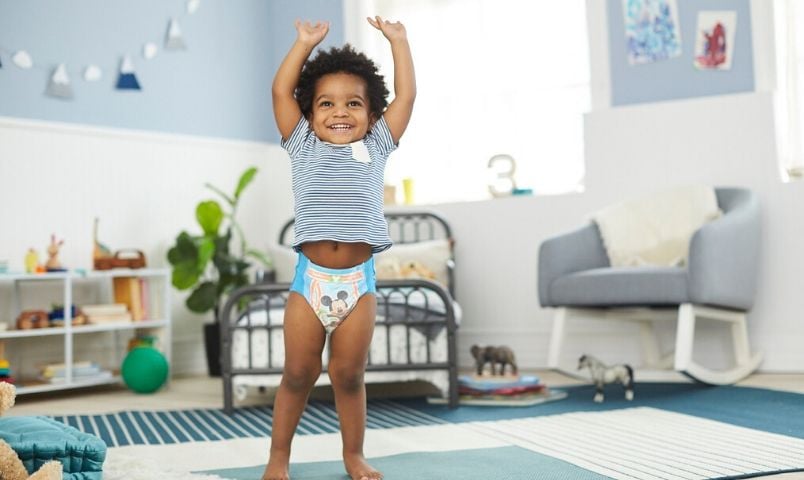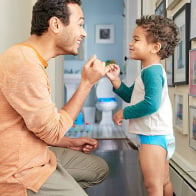Introducing Pull-Ups® training pants is a big, symbolic moment in your child’s development. Your little one is no longer a baby, but a toddler! Making – and sticking with – the training pants transition is important to the potty training journey you’re taking together.
Here’s how you can build consistency as you launch your potty training adventure — and other important tips for easy and fun potty training.

How to Be Consistent with Potty Training
- Acknowledge this important achievement. Potty training isn’t just a skill – it’s actually the signature developmental achievement of toddlerhood. Toddlers’ brains and abilities aren’t fully developed, so mastering a complex skill like potty training is a pretty tall order. This iconic journey requires coordinated physical, emotional, moral and cognitive development along the way. Switching from diapers into Pull-Ups® training pants shows your child you appreciate – and support – all the growth that’s gone into the major transition from passive baby to active toddler.
- Remember that you’re in it together. Now that the potty training journey has begun, make the first time they put on Pull-Ups® training pants a special one. This is an opportunity to reinforce the promise that you’re in it together, on the potty training journey and beyond. This Potty Promise has two parts – your toddler’s drive to be a Big Kid and your support, love and dependability along the way. Make this a bonding moment for both of you — one that sets the tone for your parent/child partnership. You’ll get through this as a team!
- Practice before you start training. While you’ll surely be excited to get your toddler on the potty, first practice using their Pull-Ups® training pants. Being able to get dressed on their own is a big milestone in your child’s development — and an important potty training skill. Show them how to pull the pants up and down, and make sure they’ve mastered that skill before you get them on the toilet.
- Boost learning through consistency. Toddlers thrive on consistency, which helps them practice and feel comfortable with their new skills. You can help by explaining to your child that diapers were made for babies, but Pull-Up® training pants were made for toddlers who are learning to be Big Kids.
Pull-Ups® training pants help during potty training because they’re designed specifically to help your child learn and practice new skills, like pulling pants up and down. Ditching the diapers and sticking with Pull-Ups® training pants helps remind your child of the new potty skills they’re working so hard to learn. - Model how it’s done. Children love to mimic their parents and siblings. Boys can learn from watching their dads, and girls and learn from watching their moms. If a same-sex parent isn’t available for potty training, consider asking a close family member to demonstrate how it’s done. For boys, keep in mind that both sitting and standing can be confusing. If you’re training a boy, consider teaching him to pee sitting down first.
- Have realistic expectations. No two kids are the same. And no two kids will have the exact same experience with potty training. Remember that it takes eight months on average to potty train a child. Don’t worry about pressure you might get from friends or family members about when you to start the potty training process — or how long it’s taking for your child to be potty trained. It will happen when your child is ready, and the best way to help them get there is through encouragement and consistency.
- Cheer on your potty user. Kids thrive on encouraging words — and for some kids, little rewards are a big motivator in the potty training journey too. Figure out which rewards will work for your child including Time to Potty certificates you can download. Some kids love stickers or a training chart to document their progress while others like to share their success by calling up Grandma or Grandpa.
- Enlist support. If your kid goes to daycare, has a babysitter, or spends time with Grandma and Grandpa, make sure these caregivers are on board with your training plan. Keeping everyone on track with the same approach can help eliminate any confusion for your child — and ensure the encouragement happens whether they’re at home or away.
- Make it fun. Let’s be honest: On your potty training journey, you’ll have days that make you want to jump up and down and cheer. And, you’ll have days that make you feel like the process is slower than you were hoping. The best way to keep a positive mindset through it all is to make potty training fun.
Potty training is a process, with you and your child working together toward the same goal. Your toddler is working to build a complex, lifelong skill over this potty training journey. And your guidance, support and patience will help set the tone of your relationship for the years to come.











